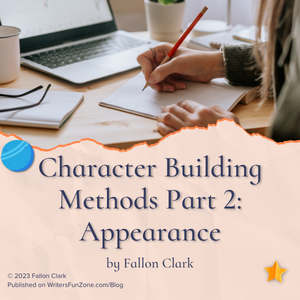Character Building Methods Part 2: Appearance by Fallon Clark
 Let’s welcome back Fallon Clark as she shares with us “Character Building Methods Part 2: Appearance.” Enjoy!
Let’s welcome back Fallon Clark as she shares with us “Character Building Methods Part 2: Appearance.” Enjoy!
***
What’s the first thing that comes to mind when you see a person wearing a tee shirt emblazoned with a hammer and sickle?
How about a bright red baseball cap?
Truth is, a person’s appearance, at least in part, tells us how they view the world and often makes statements about that person’s internal values system.
Politics. Religion. Intellect. Principles.
The essential parts of what it means to be that person.
A woman wearing a ballgown makes a different statement than one wearing fishnets and a miniskirt.
A smoking jacket and a wooden pipe tell something different from a palmed joint or a blackened spoon.
Leveraging appearances allows you to communicate something essential about your character to your reader with grace and relative brevity.
In last month’s Story Path newsletter, I shared with you dialogue tips to level-up your characters. This newsletter issue covers the second method of characterization: appearance.
And appearances are everything.
On Appearances
Have you ever walked into a room of new faces, the tension palpable as you scanned the crowd searching for a group of warm and welcoming souls with whom to rub elbows, a place to fit in?
You likely looked for “your people” using the most basic of human senses. And as you scanned, you mentally disregarded those with whom you didn’t foresee a relationship.
And all of this judgement happened in a fraction of a second.
While beauty may be only skin deep, one’s appearance plays a massive role in how we are judged and how we judge in our day-to-day lives.
Because as much as we may want to learn of one’s inner beauty (or ugliness, tbh), that beauty has to come to the surface in some way for us to perceive it in the moment of judgement.
While some writers shy away from providing detail about character appearances to allow tension and conflict to unfold from inner truths, appearances are the first thing you — and your readers — will see about your characters.
Embodiment
When it comes to surfacing appearances, we know that speech (see Character Building Methods, Part 1: Dialogue) and action (Character Building Methods, Part 3: Action coming in September) have their roles to play.
But appearance prompts our initial reactions to people. Everything else presents some part of their inner selves. When setting up important characters, give your reader a chance — right away — to perceive these other characters through the eyes of your viewpoint character, to form connections or aversions to these people based on your viewpoint character’s perspective.
In Sara Gruen’s Water for Elephants, narrator Jacob has two starkly different impressions of important people in his life about 20 pages apart. Both scenes are in the novel’s setup, both provide insight into Jacob’s experiences, fears, and desires.
Rather than relaying or overdescribing Jacob’s grief, which can come off as shallow or try-hard (because telling readers what to think almost never works), Gruen allows Jacob to notice his mother the way a son would.
The word choices Gruen makes to describe Jacob’s experience as a witness to his deceased parents show readers the horrifying visual and allow readers to make contrasting assumptions.
Patterns or texture that is mottled and battered.
Colors of eggplant purple and bloodless white.
Matted and bloodied hair.
An open mouth, a grimace.
This image contrasts the briefly mentioned beauty and meticulousness of Jacob’s mother in life.
And compare the appearance of Jacob’s mother in death to the appearance of Marlena, who will become his love interest, in his young adult life.
Gruen uses a comparison to a former love interest Jacob had back at home and constructs an image of magic for Marlena in the choice of language.
Readers know Jacob finds Marlena attractive in his caught breath, recognize the fantasy in his imagining.
And against the backdrop of black and white horses and the top-hat man, Marlena is a sparkling glass of pink champagne.
You can almost hear the bubbles popping and sloshing about as she adjusts her headdress. Marlena becomes a sign of life in Jacob’s grim reality.
Physical Movements
Beyond the surface-level appearance of a character, allowing readers to see how a character moves can clue them in on essential parts of your character, to allow readers to understand something fundamental to that person that they may not otherwise glean from clothing or features alone.
Physical movements of characters can both distinguish them and add meaning to scenes.
In Delia Owens’ Where the Crawdads Sing, viewpoint character Kya, the marsh girl, after receiving a big blow brought on by bad news, leverages the marsh to gain her composure.
Kya could have had an emotional outburst after processing the bad news, but Owens skillfully kept Kya from wallowing — it would have been out of character for her.
Instead, Kya throws herself into something she knows well, using her physical movements — choosing, stashing, flipping, lining, planning, reading, embarking, avoiding — to showcase how badly the news has affected Kya.
Rather than focusing on something that feels too big, Kya focuses on something small, something she knows well, something comforting. And this focus lends to her vulnerability in the moment even as she avoids “the strongest current altogether.”
Compare the passage of a vulnerable Kya above to the one below, which showcases her frenetic terror in another moment of vulnerability brought on by intimate partner violence and the threat of rape.
Again, Kya doesn’t wallow, but Owens leverages her movements — pulling, grabbing, snapping, cussing, expecting, turning, accelerating, shaking, looking — to show readers how much like a scared animal Kya actually is. She’s having an instinct-based flight response, and the language Owens uses details those instincts, showing readers Kya’s roiling inner turmoil through the small action of holding herself with one arm.
Using Appearance to Show Character
Picture your character at a particularly intense moment in your story. Notice what your character wears, how they hold themselves, even the angle of their chin.
What impressions of others does your character hold?
What perceptions of themselves do they hold?
What body language and movement can you use to highlight their emotions without telling readers how the character feels?
Check in next month for the third method to craft characters with whom readers may bond: action.
Happy writing and editing!
♥ Fallon
***
ABOUT THE AUTHOR
 Fallon Clark is an independent story development coach and editor serving fiction and creative non-fiction authors. Her fiction has been published in Flash Fiction Magazine. When not editing or writing, you will find her gardening, reading tarot, or staring into the universe’s star-crusted abyss to wonder, “What if?”
Fallon Clark is an independent story development coach and editor serving fiction and creative non-fiction authors. Her fiction has been published in Flash Fiction Magazine. When not editing or writing, you will find her gardening, reading tarot, or staring into the universe’s star-crusted abyss to wonder, “What if?”
CONNECT WITH FALLON:
Web: https://www.fallonedits.com
LinkedIn: https://www.linkedin.com/in/fallonedits
Quora: https://www.quora.com/profile/FallonEdits
Minds: https://www.minds.com/itsmefal










